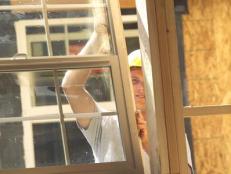Peel-and-Stick Window Flashing
The way in which you install windows in a home greatly affects how well those windows perform. You need a good seal — one that guides water around the window opening and keeps the interior wall protected and dry. By using window flashing instead of caulk, you can increase protection from the weather for years to come.
This is important because a window can be a potential weak point in your wall for moisture. You'll want to use the right product and install it correctly. Improper installation can result in water leakage, mold, warping and, eventually, structural damage, requiring costly repairs!
The best practice for installing a window uses peel-and-stick window flashing. The benefits of this product are its ability to form a watertight seal around the window and to seal tightly over nails and staples. This is an advantage over ordinary contractors' tape and caulk.
Here's how you do it:
- Cut the house wrap at the top of the header at a 45-degree angle to create a flap. Tape the flap temporarily out of the way.
- Apply the peel-and-stick flashing to the sill first, then lap the flashing up on the jambs.
- Next, caulk all around the window opening except on the sill. After caulking install the window.
- Next apply the flashing to the side jambs of the window so that it overlaps the edges of the sill and extends down past it by 1 inch and extends past the window head by 2 inches.
- To direct water out beyond the top of the opening. Extend the header flashing piece past the jambs by at least 1 inch. If the window has a drip cap, have it installed beforehand so that the flashing can cover it.
- After installing the header flashing, fold the house wrap flap back over, taping it down so that the house wrap material overlaps the header flashing.
Before peel-and-stick flashing was available, the typical method of weatherproofing windows was to use contractors' caulk around the sill, header and jambs of the window opening. Although this creates a seal between the window and the frame, this is not the best way! While caulking is important, you can't rely on caulk to keep water from getting in.
Over time, as caulk deteriorates and the window frame expands and contracts, it will separate from the wall. This allows water to seep in, causing damage to the wood frame in the summer and ice buildup in the winter.
Flashing windows with a peel-and-stick flashing is a better way. It will provide a smooth drainage plane and a better seal against water, and it will reduce the chance of rot and warping over time.
Please remember, if you use a peel-and-stick flashing, always allow for the window opening to be over-framed in its measurements by 1/4 inch in each direction. This will accommodate the additional flashing material and give the window a tight seal.







































